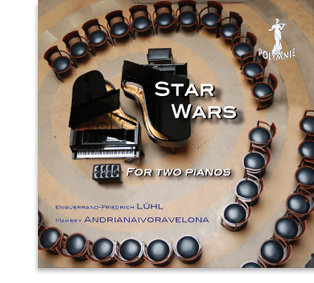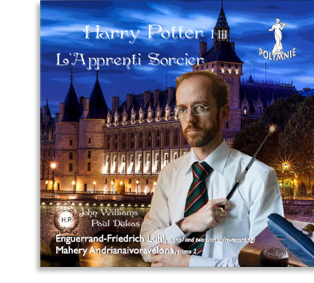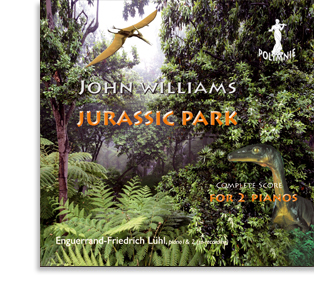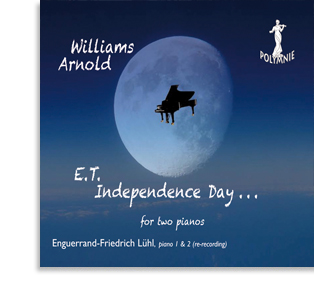 |
|||||

John Williams, Indiana Jones for
two pianos
Enguerrand-Friedrich
Lühl-Dolgorukiy, piano
Mahery
Andrianaivoravelona, piano
POL 208 145
John Williams
Indiana Jones
Fox Fanfare
Indiana Jones II - End Credits
Indiana Jones I - In the Jungle - The Cave - The Rolling Ball
Indiana Jones I - Flight to Freedom
Indiana Jones I - The Book
Indiana Jones I -Thinking of Marion -To Tibet
Indiana Jones I - The Medallion
Indiana Jones I - To Cairo
Indiana Jones I - The Map Room - Dawn
Indiana Jones I - Indie in Pursuit
Indiana Jones II - End Credits
Indiana Jones III - End Credits
Indiana Jones IV -The Crystal Skull
Indiana Jones IV - Irina's Theme
Indiana Jones IV - Swashbuckler
Indiana Jones IV - Marion's Theme
Indiana Jones IV - A Whirl through Academe
John Williams... 40 ans de carrière pour piano
Né en 1932, auteur en outre de quatre hymnes olympiques (Los Angeles, Séoul, Atlanta et Salt Lake City), chargé de la partie musicale de l’investiture de Barack Obama, à présent titulaire de 5 Oscars (49 nominations), de 4 Golden Globes, de 7 BAFTA Awards et de 21 Grammy Awards, ayant été intronisé au Hollywood Bowl Hall of Fame en 2000 et récipiendaire du Kennedy Center Honors en 2004, John Williams est devenu, après Walt Disney, l’artiste cinématographique le plus récompensé de l’histoire du cinéma.
Le travail de Williams
Chaque compositeur a sa propre méthode de
travail. Williams, après l’élaboration sommaire des grandes
ambiances générales du film concerné, dresse un canevas orchestral
pour instrumentarium réduit (10 à 12 instruments) et laisse, faute
de temps pour le faire lui-même, ses orchestrateurs parfaire et
affiner l’œuvre. Il est aujourd’hui l’un des rares compositeurs à
toujours écrire à la main, la majeure partie des compositeurs
utilisant une logistique informatique permettant des changements
d’orchestration de dernière minute pendant les sessions de
répétition ou d’enregistrement avec l’orchestre en synchronisé
avec la projection du film. Une fois la musique intégralement
enregistrée, elle peut subir de sévères coupures dues à
d’éventuels montages postérieurs, ce qui rompt la structure des
enchaînements musicaux. Malheureusement, le plus souvent, ces
coupures abruptes sont faites au profit de l’image et dénaturent
la qualité de la construction musicale.
Une fois la musique pour le film entièrement composée et
enregistrée (en partie rejetée et recomposée à la demande du
réalisateur), Williams crée une Suite de concert des meilleurs
moments musicaux du film, rassemblant les principaux thèmes afin
qu'ils soient plus facilement joués en salle individuellement pour
un programme composite. C’est ainsi que nous pouvons trouver les
partitions d’une ‘Children’s suite’ de Harry Potter I, trois
pièces de Schindler’s List, une suite des épisodes I à IX de Star
Wars, une longue pièce symphonique de E.T... Chaque œuvre est
remaniée musicalement, parfois augmentée de passages inexistants
dans le film en réutilisant le même matériau musical. Les suites
de concert sont destinées à être jouées sans accompagnement
cinématographique.
Le travail de Lühl
Travaillant pour la diffusion des œuvres de
Williams depuis 2006, Lühl a transcrit fidèlement près de 60
titres du compositeur américain pour piano seul et deux pianos. La
première surprise que l’on découvre grâce à ces transcriptions,
dont chaque note de l’immense appareil orchestral est reprise aux
pianos, est la limpidité des différentes voix qui se retrouvent
inondées dans la masse orchestrale d’origine : le discours devient
transparent et presque évident.
Pour une plus grande ‘vulgarisation’ de ces thèmes qui hantent les
esprits des spectateurs admiratifs, divers arrangeurs publient
d'habitude - parfois même anonymement - des recueils pour piano
rassemblant normalement les meilleures pages des films illustrés
par Williams. Cependant, ces arrangements, destinés au pianiste
amateur, tronquent considérablement les pièces et les simplifient
à outrance au point qu’on peut à peine en reconnaître l’original.
Cette bien faible retranscription détruit, par la réduction à
l’état de simplicité musicale extrême, le caractère de l’œuvre.
Une œuvre de neuf minutes pour orchestre peut ainsi se retrouver
compressée sur deux pages pour piano et durer neuf fois moins,
juste pour qu’on puisse se dire que l’on est capable de jouer le
thème de E.T. – l’Extraterrestre ! La qualité de ces arrangements
nuit à l’original pour les puristes et de nombreux pianistes ne
rêvent que d’une chose : pouvoir un jour revivre l’aventure de
manière réaliste en marchant dans les pas de l’œuvre avec un
arrangement complet.
C’est ainsi qu’ Enguerrand-Friedrich Lühl entreprend son immense
travail d’arrangement des œuvres de John Williams pour piano seul
et deux pianos, désireux de faire connaître au public et au
pianiste avancé la musique de Williams sous un autre angle : le
piano symphonique avec toute la palette sonore que ce magnifique
instrument est capable de déployer. Toute la dimension symphonique
doit être fidèlement exécutée par deux ou quatre mains.
Lühl explore toutes les facettes de son instrument, faisant appel
à des techniques percussives contemporaines rappelant les bongos,
les cymbales, la grosse caisse, la caisse claire, le chimes ou
même la harpe. Rien n’est épargné pour mieux contribuer au
réalisme de l’ambiance à retracer : couvercle, bois frappé, cordes
pincées, troisième pédale ‘tonale’, parties corporelles des
pianistes (ongles, plat de la main, doigts frappés, genoux, le
tout parfois même simultanément à deux pianos pendant le jeu
digital !). L’ensemble entraîne l’auditoire dans un monde
fantastique et imaginaire, où enfin, il pourra entendre les
versions complètes des pièces qui l’ont fait rêver durant sa
jeunesse.
Genèse d’un défi musical
Si Indiana Jones et le Temple maudit a été
réalisé après Les Aventuriers de l’Arche perdue, ce deuxième
épisode
de la saga situe l’action à Shanghai, puis en Inde en
1935, alors que L’Arche perdue se passe en 1936. De plus, il
paraît incontournable de débuter ce programme par le thème
principal, figure de proue musicale du protagoniste. Le reste de
la musique du générique de fin comporte le deuxième thème annexe
du film, la Marche des enfants esclaves, parfois même combiné avec
celui d’Indiana Jones. Une grosse partie de ce disque est
consacrée à L’Arche perdue et illustre environ les vingt premières
minutes du film en respectant l’ordre chronologique
de l’action. Le générique de fin d’Indiana Jones et la dernière
Croisade reprend les principaux thèmes du film, incluant le
redoutable "Scherzo pour moto & orchestre ". Nous rapprochant
de la période de la Guerre Froide, Indiana Jones et le royaume du
crâne de cristal comporte une suite symphonique en cinq mouvements
avec de nouveaux thèmes propres au film. Un détail musicologique
intéressant se trouve dans A Whirl through Academe, séquence
pendant laquelle Indiana Jones et son fils Mutt Williams sont
pourchassés par les méchants dans une folle course-poursuite en
moto sur le terrain d’une académie. Williams a habilement inséré
dans cette pièce un clin d’œil à l’Ouverture Académique op.80 de
Johannes Brahms, citant le deuxième thème de l’œuvre romantique
pendant seulement quelques secondes. Ce thème est d’ailleurs tiré
d’une marche d’étudiants allemand intitulée "Fuchslied" (chanson
du renard).
![]()




![]()
Born in 1932, besides being
the author of four Olympic hymns (Los Angeles, Seoul, Atlanta
and Salt Lake City), American Hollywood composer John Williams
now owns 5 Oscars (he was nominated 49 times!), 4 Golden Globes,
7 BAFTA Awards and 21 Grammy Awards. In 2000 he entered the
Hollywood Bowl Hall of Fame and received the Kennedy Center
Honors in 2004, John Williams which makes him the most awarded
individual in the history of the motion picture since Walt
Disney.
Williams’ work
Every composer has his own
method of working. Williams, after composing his themes and main
musical atmospheres of the movie at the piano, writes down a
particell for small orchestra (10 to 12 instruments) and leaves
the final orchestration, because of lack of time, to his
orchestrators. Today, he is one of Hollywood’s rare composers
who still writes by hand and not use increasingly complex
software like most of his contemporaries. Then, the editor
prints the separate parts for each instrument of the orchestra
and last minute changes occur during rehearsals or the recording
sessions while synchronizing with the organic motion of the
film. Once the music is completely recorded, it is often cruelly
cut for future video editing which breaks the musical structure.
Unfortunately, such cuts, made to enhance the plot, tend to
damage the quality of the musical integrity behind the image
flow. Once the musical composition for the film is completed and
entirely recorded (some parts being rejected or sometimes even
recomposed according to the director’s instructions), Williams
creates a concert suite of the best musical moments of the film.
For example, his editor has published the score of a Children’s
Suite from Harry Potter I, three pieces from Schindler’s List, a
concert suite from the Star Wars saga and a long symphonic piece
from E.T. – the Extraterrestrial, featuring music which doesn’t
appear in the films. Each piece has therefore been musically
revised, sometimes by adding new musical sequences and reusing
similar musical material. These concert suites are generally
designed for a concert performance of film music.
Lühl’s work
Lühl has faithfully
transcribed around 70 pieces from John Williams’ film music
repertoire, and one immediately notices how neat his rich
orchestral scores become when looking at them through only one
type of instrument.
To reach a broader audience for these themes
haunting the minds of admiring viewers, many composers usually
arrange – sometimes even anonymously – pieces for piano
assembling the best parts of films musically illustrated by
their respective composers. However, these arrangements,
conceived for amateur pianists, sever the pieces dramatically
and simplify them to the point that one barely recognizes the
original score. This horribly weak adaptation destroys the
work’s genuine character and reduces it to the slight minimum –
the main theme and a primitive accompaniment! A work of nine
minutes for orchestra is accordingly compressed into a
one-minute pieces of two piano pages – just for the pleasure of
the amateur performed calming that he is capable of playing the
'ET theme'. The quality of such scores does not do credit to the
original purists and fans and many more serious pianists can
only dream of one thing: relive the musical journey in a more
realistic and demanding way by playing more of the original work
than only a few reductive pages.
For this reason, Lühl started his tremendous work by
enthusiastically adapting orchestral pieces by John Williams for
piano solo and two pianos in a desire to make the public aware
of John Williams’ musical quality from another perspective: the
symphonic piano with all its variety of organic sounds! Lühl
therefore decided to explore all the aspects of the instrument,
using the piano as a contemporary tool which would recall the
effects produced within the orchestra: bongos, cymbals, bass
drum, chimes, harps, etc. Everything contributes to the
atmosphere’s realism by e.g. hitting the piano lid and creating
wooden sounds, pinching strings, using other body parts than
only the fingers (nails, palms of the hands, knees, even at the
same time during the performance). Finally, Lühl will be able to
hear both new and authentic versions of the pieces he dreamt
about in his childhood.
Genesis of a musical challenge
If Indiana Jones and the
Temple of Doom has been released after Raiders of the lost Ark,
this second episode from the saga sets the plot in 1935 – first
in Shanghai, then in India –, whereas Raiders takes place in
1936. Therefore, in order to respect the chronological order of
the four film series, and at the same time, introduce the March
of Indiana Jones, it was necessary to begin with the sequel
instead of the original first movie.
A major part of this program is dedicated to Raiders and the
suite follows the chronological order during the first twenty
minutes of the movie. Indiana Jones and the Last Crusade’s end
credits include the formidable “Scherzo for motorcycle and
orchestra”, in this present version transcribed for two pianos.
As for the last episode of the Indiana Jones chronicles, this
time unfolding during the Cold War, the Kingdom of the Crystal
Skull features a five-movement symphonic suite taken by Williams
form his movie score and adapted for a live concert performance.
In the last piece, Indiana Jones and his son Mutt Williams are
being pursued by the baddies and lead their side-car motorcycle
right across the terrain of a renowned academy. At this point,
John Williams added a quotation to his music inspired by
Johannes Brahms’ Academic Festival Ouverture op. 80. The work’s
second theme is in itself a quotation from a merry song
performed by 19th century German student’s entitled Fuchslied
"song of the fox".
Lühl-Dolgorukiy
travaille en collaboration avec les éditions phonographiques
Polymnie pour l’intégrale de l’enregistrement de ses œuvres.
Sont déjà disponibles ses quatre premiers Quatuors à cordes (POL
480 243 et POL 480 364), le
Requiem Vauban (POL 790 344), sa
cinquième Symphonie sous sa direction (POL
990 361) et de nombreux CD Rachmaninoff, dont le deuxième
Concerto pour piano op. 18 et la Rhapsodie sur un thème de
Paganini dans une réduction pour deux pianos de l’auteur (POL
150 865). Notons aussi un travail considérable
avec l'édition des oeuvres de John Williams Star Wars (POL
151 686), Harry Potter (POL
105 109), Jurassic Park (POL 108
115)... d’autres albums sont en préparation.
Lühl's recordings are available at the music label
Polymnie, for which he already recorded several works of his
own, conducting an orchestra for his Fifth Symphony (POL
990 361), or playing the piano, and more recently a CD of
piano pieces by S. Rachmaninoff and the Rhapsody on a theme by
Paganini as well as the Second piano concerto op. 18 (POL
150 865), also several CD by John Williams, Star Wars (POL
151 686), Harry Potter (POL
105 109), Jurassic Park (POL 108
115)... Lühl is planning to record his entire work (about
50 CDs).
![]()
Mahery Andrianaivoravelona
s'est produit pour la première fois comme pianiste avec
orchestre à l'âge de 13 ans en interprétant le 9ème Concerto
K271 "Jeune homme" de Mozart. En 1991, il entre au CNSM de Paris
dans la classe de piano de Michel Béroff et suit parallèlement
des cours de musique de chambre. Il obtient quatre ans plus tard
le Diplôme de Formation Supérieure du CNSM de Paris, ainsi que
diverses récompenses en histoire du jazz, en acoustique, en
déchiffrage et en analyse. Suite à cela, il remporte divers
Premiers Prix de Concours Nationaux et Internationaux tels que
ceux du Royaume de la Musique, du Concours Claude Kahn ou encore
du Concours de Saint-Nom La Bretèche et est depuis invité à se
produire en récital en France, en Allemagne
(Hattersheim/Düsseldorf), en Italie (Rome), en Tunisie
(Hammamet) à La Réunion, et dernièrement à Madagascar, à
l'occasion de festivals, congrès médicaux ou pour des œuvres
caritatives (concerts au profit des victimes du cyclone «
Geralda » à Antananarivo). Parallèlement à son activité de
concertiste, il mène régulièrement une action pédagogique active
à Madagascar au travers d'ateliers, de Master Classes, de
concerts et de jury de concours.
Mahery Andrianaivoravelona
first performed as a pianist with orchestra at the age of
thirteen when he played Mozart’s 9th concerto K271. In 1991 he
began his studies at CNSM of Paris with M. Béroff and at the
same time followed courses in chamber music. Four years later he
received his diploma from the CNSMDP as well as many awards in
history of jazz, acoustics and musical theory. After that he won
various first prizes nationally and internationally such as the
Royaume de la musique, the Claude Kahn competition and the
international Saint-Nom- la-Bretèche competition. He has also
played internationally in France, Germany and Italy, Tunisia, La
Réunion and lately in Madagascar for festivals and special
events. Since 2004 he performs in duo with the pianist and
composer Enguerrand-Friedrich Lühl. They are preparing a series
of concerts for Musique et Toile. In parallel to his activity as
a concert pianist he organises special music workshops for
master classes, concerts and juries in Madagascar.
![]()
Accueil | Catalogue
| Interprètes | Instruments
| Compositeurs | CDpac
| Stages | Contact
| Liens
• www.polymnie.net
Site officiel du Label Polymnie • © CDpac • Tous droits
réservés •



